
By Sandeep Sahu
The BJP, we are told, is in the process of preparing a blueprint to win nine Lok Sabha seats in Odisha - in eight of which it had emerged second the last time round - in the next general elections (Union Tribal Affairs minister Jual Oram had won the Sundargarh seat for the party). The ‘action plan’ will be submitted to the party’s central leadership by October 15.
But how realistic are the saffron party’s chances of registering a win in these nine seats?
The 2019 elections are a good three years away and in the absence of any polls in the recent past, there are no real pointers from the ground on whether there has been any upsurge in the BJP’s fortunes – or any decline in the support base of the BJD. At a time when opinion polls – and even exit polls – are facing a serious crisis of credibility after being repeatedly proved miles off the mark, any prediction about the outcome of an election three years down the line is fraught with grave risk. But there is no harm trying to pick a few strands that are discernible in the political arena to hazard a guess. [After all, much of the charm of Indian politics will vanish if we do away with the ‘game’ of political crystal-gazing altogether!]
The most obvious of these political strands is the change in the equation between the BJD and BJP since May, 2014. For close to two years after the election, the two estranged partners gave the distinct impression of inching closer to each other. The picture of BJD supremo Naveen Patnaik meeting the newly elected Prime Minister Narendra Modi with all his 27 MPs – 20 in the Lok Sabha and seven in the Rajya Sabha – in June, 2014 is still fresh in the memory. In the days, weeks and months that followed, the enviable bonhomie between the two sides manifested it in myriad ways spawning talk of a new equation between them.
The tell-tale signs of this equation were there for anyone to see. The CBI, which had been breathing down the neck of BJD (at one stage, even reaching the door steps of Naveen Nivas), was suddenly taken off its back and the ruling party began breathing easy again. On his maiden visit to the state in January, 2015, BJP president Amit Shah stubbornly refused to utter a single word against the Naveen Patnaik regime despite all provocation by a persistent media. Even as state leaders of BJP went hammer and tongs against the BJD government, the central leadership of the party and Union ministers refused to take on Naveen. Why, even the Prime Minister described him as his ‘param mitr’ (great friend) at a public meeting in Rourkela. With the BJP lacking the numbers in the Upper House to get some key legislation passed, this was a marriage of convenience that made eminent political sense.
But of late, the relationship between the BJD and BJP has undergone a sea change. The visible bonhomie has now been replaced by open war – its latest pointer being the egg attack on voluble Agriculture minister Pradeep Maharathy in Bolangir. If one were to put a finger at the exact point where the relationship soured, it has to be the attack on Union minister Santosh Gangwar’s convoy in Bargarh in June this year. It is safe to predict that the relationship between the two parties would get progressively bitter in the days and weeks ahead.
It is obvious that for the BJP to entertain any thoughts of winning all or some of these seats, it has to further up the ante against the ruling party. It wasted nearly two years by trying to play ball with the BJD and any overt or covert deal making at this stage will be a recipe for certain disaster.
Now, let us consider the eight parliamentary constituencies (not taking into account Sundargarh which it won) the BJP has penciled in as ‘winnable’ seats. Interestingly, the party lost in five of these seats with a margin of over one lakh votes. These are Bolangir (losing margin 1, 04, 299), Mayurbhanj (1, 22, 866), Dhenkanal (1, 37, 340), Balasore (1, 41, 825) and Bhubaneswar (1, 89, 477). Even allowing for a decline in the BJD’s support base since the last elections, it is difficult to see how the BJP can wipe out this considerable deficit to register wins in these seats. It is obviously banking on a further decline in the BJD’s voter loyalty before the next election is due.
Curiously, the list of ‘winnable’ seats drawn up by the BJP does not include Keonjhar where too the party emerged second behind the BJD. If the ground for exclusion of Keonjhar was the losing margin of 1, 57, 317, then how on earth does the list have Bhubaneswar where the margin was even bigger at 1, 89, 477? And its margin of victory in the lone seat it won (Sundargarh) was not big enough (just 18, 829) to assume it would be a cakewalk the next time.
That leaves just three seats in the list of nine – Bargarh (11, 178), Sambalpur (30, 576) and Kalahandi (56, 347) - where the party can hope to recover ground in time for the next election. Not surprisingly, all these three seats are in western Odisha where the BJP has always been more of a force to reckon with than it has been in the coastal belt where the BJD rules the roost. To win outside its traditional stronghold, the party has to enter into an electoral understanding with some of the smaller parties.
On its part, the BJD clearly is not quite the force it was in April, 2014. The involvement of several of its leaders in the chit fund scam and the series of other scams that have surfaced since it won a stunning 20 out of the 21 Lok Sabha seats have dented its image considerably. Of late, Naveen too has given the impression of a leader who is not quite in control of the party and the government. The once decisive party supremo, who sacked ministers for merely being ‘under the shadow of corruption’, is unable to act against his ministers and other party leaders even when considerable evidence of their involvement has surfaced in the public domain. Naveen’s own spotless image too has been severely dented in the wake of revelations about how his government looked the other way while chit fund companies fleeced the public of crores despite repeated warnings by central agencies. The Justice MB Shah Commission report, which pegged the decade-long mining scam under his watch at Rs 60, 000 crores, has certainly not enhanced his reputation as a leader who does not tolerate corruption.
May be Naveen, who certainly reads the signals from the ground better than all his rivals, knows his stock is falling. May be that is the reason he is constantly on the lookout for any segment that may have been left out (or not had enough) in the showering of sops that has marked his regime since its third innings. It is, however, difficult to guess at this stage if he can recover the ground he has lost with more doles.
The panchayat polls scheduled for next February should tell us if he has. It will be the first major electoral exercise since Naveen registered that stupendous victory in the summer of 2014 to become Chief Minister for an incredible fourth straight time. It would also tell us whether the Congress, which looks a bit lost now, has any hopes of revival before the next general elections or is resigned to the BJP usurping its position as the principal opposition party in the state.










